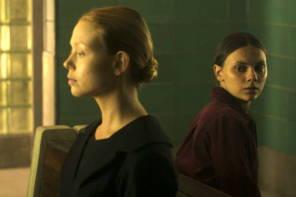On Monday, July 8, the Senate Committee on Health and Human Services (HHS) of the Texas Legislature heard more than 13 hours of testimony regarding SB1 (Senate Bill 1), a bill designed to “regulat[e]… abortion procedures, providers, and facilities.”
These regulations, which include mandates that abortion providers have hospital admitting privileges and that abortion facilities meet the “standards… for ambulatory surgical centers,” could result in the shutdown of a majority of clinics that offer abortion and health services to women.
During Monday’s official proceedings, tears and confessions, facts and statistics, blatant propaganda and earnest pleas, punctuated testimonies offered on both sides of the bill. Unofficial proceedings turned the Capitol’s open-air rotunda into a public forum.
One activist pronounced pro-life the “truly Christian” stance; another expressed dismay that “‘they’ always paint ‘us’ as godless.” All the while a man walked about the rotunda bearing a notebook-sized sign with the word “theocracy” crossed out.
It was a day of high stakes and emotion as people continued to debate the role of government, faith, and human agency in questions of how or why to regulate women’s bodies. Over the next days, the Texas House and then Senate will conduct their floor debates.
It was just two weeks ago that Texas Sen. Wendy Davis, together with other elected Democrats and citizen-activists, successfully carried out a filibuster of SB5. (Do not be thrown by the number change. SB1 and its companion legislation HB2 [House Bill 2] are reboots of that filibustered legislation that, as HB2 author Rep. Jodie Laubenberg repeatedly articulated in the hearing on her bill, refuse amendment, change, or even compromise.)
As I and others prepare for the long haul and political plays sure to encompass the Texas abortion legislation, I am thinking back to an encounter I witnessed a week ago—one that gives me a degree of hope regarding the fullest possibilities of civic engagement.
Let me set the scene:
On Monday, July 1, thousands of Texans gathered to protest restrictive abortion bills. Governor Perry vowed to stand steadfast against “the breakdown of decorum and decency” fomented by, in Lt. Gov. David Dewhurst’s words, that “unruly mob” who thwarted passage of SB5.
And yes, the unruly were rallying once again. Orange of every shade—the official color of pro-choice activists in the debate—flooded the south steps of the Capitol. Texas Senators and Representatives, including Kirk Watson, Leticia Van de Putte, Senfronia Thompson, and, of course, Wendy Davis, offered stirring speeches; Natalie Maines sang the National Anthem; Texas religious leaders spoke of God, faith, trust in a woman’s ability to choose, and love of neighbor.
The rally wound down as elected officials and citizen-activists headed inside the Capitol. The bills were presented to the legislature. Discussion ended, and HB2 and SB1 were sent to committee.
Procedural maneuvers may have been concluded for the day, but the politics were just getting started. While checking out the latest update from Stand With Texas Women on Facebook, I heard Texas Sen. Donna Campbell on the local news declare that “Democracy was traded for mobocracy” during the successful filibuster.
Mobocracy, really? Needless to say, the proverbial line was drawn in the sand, yet again.
The orange-clad were directed to arrive at the Capitol the following day, July 2, ready to register their stance on HB2 and, if desired, to sign up to testify before the House State Affairs Committee.
I arrived a couple of hours early. Walking through the Capitol and down to the E2 level to register my position on the bill, I was greeted by a few orange-wearing folk. They were outnumbered by anti-abortion activists, wearing blue, and I felt a little intimidated—so much that I texted a friend for moral support.
Once I had registered, I walked back through the main hall to a table set up for those opposed to the bill. A woman stationed there greeted me, “What is up with the blue people?” she asked. “It’s like we’re contagious. Have you noticed how they look at us?”
I had noticed, but chalked it up to the ever-deepening chasm of misunderstanding between pro-choice and pro-life advocates.
As the day wore on, I saw more and more people in orange. “Ah, my people,” I sighed, relieved. Some of the orange-clad even had walkie-talkies, and were strategically directing us to overflow rooms for the hearing. We wanted to make a good show of orange and opposition. I dutifully stood, along with eight others, in front of E2.010 and waited.
The committee meeting began. Procedures were briefly outlined, and we were informed that over 1600 individuals had registered to testify. That number was quickly growing, even with testimony set to end at midnight. It was gonna be a long day, and over a thousand Texans would not get to voice their opinion.
After the main elements of the bill were highlighted by its author, the games commenced.
Democratic lawmakers deployed stall tactics and asked probing questions; Republicans attempted to push through the proceedings, while rebuffing charges of procedural impropriety. Democrats pressed Laubenberg to consider amendments to her bill that would ameliorate its more draconian measures; the author rejected these overtures. One side charged the other with changing constitutional standards; that side accused the other of trading in idle speculation as to supposed outcomes of the bill, outcomes that some argue would leave only five abortion clinics in the state. Approximately 45 minutes later, the testimony started.
Experts testified, and impassioned speaker after impassioned speaker stepped up to the podium. After one gentleman opened with a prayer—which to me felt a bit like pious posturing—I stepped out into the hall.
On my right, the orange were lining people up to testify, on my far left a pool of blue stood with heads bowed. As a person of faith and in the ordination process of a mainline denomination, I was drawn to this group that stood outside, enduring the late afternoon heat, with hearts and petitions lifted up to the divine. But I was afraid they’d see my presence as either an invasion or provocation. I regret that I didn’t at least try to bridge that damn chasm. Instead, I plopped down on the nearest bench.
Right across from me sat an older woman wearing blue—red, white, and blue to be exact. The red was duct tape with the word LIFE scrawled across it. She sat with her head bowed. Prayer, I couldn’t seem to escape it.
Out of the corner of my eye, I saw a young woman, orange-skirted, wearing a white halter-top and a small tam adorned with an orange pompom—an activist for choice. She was flirting with one of the DPS officers. Love and politics in the afternoon, I smiled to myself. But what happened next surprised me.
The young woman bent down near the bowed head of the older woman, placed a hand on her shoulder, and said, “I’m sorry to bother you, but I was wondering if you’re OK.” The woman in blue lifted her head, smiled, and nodded yes. I couldn’t hear what was said next but after a few moments and shared laughs, the older and the younger, the woman in red-white-and blue and the woman in orange, shook hands.
The two remained seated for several more minutes, engaged in topics unknown. A third woman, wearing neither orange nor blue as far as I could tell, joined them. And just as quickly as they had come together, they parted. There were no shouts of “sinner” or of “sanctimonious oppressor,” no lines drawn. It was, to my eyes, a beautiful moment, an exercise of civic and civil engagement.
I was reminded of what political philosopher William Connolly has called “[a] politics of generous negotiation/coalition/contestation with friends and strangers.”
In Connolly’s model there is still contestation—there is debate over ideals passionately held. But there is no political “enemy.” Just imagine what could happen if generosity of spirit displaced partisan politics. A hand on the shoulder, an expression of concern, a moment of shared laughter, a connection that transforms a reviled opponent into a co-worker for a different kind of politics: these are the alternatives that open up when citizens and politicians refuse to engage the political other as an enemy or “unruly mob.”
Over the last several days at the Texas Capitol I’ve seen the shout-down, the shut-down, the “let’s just rewrite the rules” strategy, the “if I don’t see you, you don’t exist” head turn, and the “if only you knew the truth” condescension. Yet there have also been, as Chair Jane Nelson of the Senate HHS Committee noted during the SB1 hearing, gestures of care and concern, color-blind gestures. Perhaps these acts were merely tactical, the “kill them with kindness” ploy.
Or maybe, these moments, however rare, however fleeting, offer a glimpse of generous and yet-to-be realized coalitions that strive for the common good, whatever that might look like.
Texas, like the union of which it is a part, is built on tall tales, epic myths, and on the grand ideals of freedom, equality, and justice. I, for one, believe in the potential of politics to create more perfect unions. So today and every day that I am at the Capitol during this called legislative session, I will wear orange—not as a challenge, but as an invitation to generous engagement.
And here’s hoping we might alter the dynamics of the abortion debate, Texas-style.




